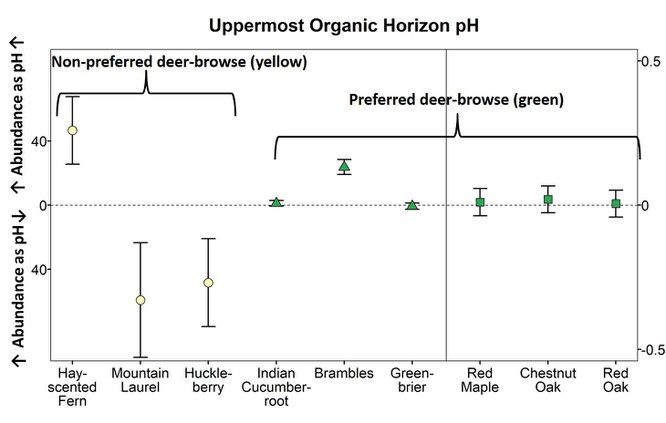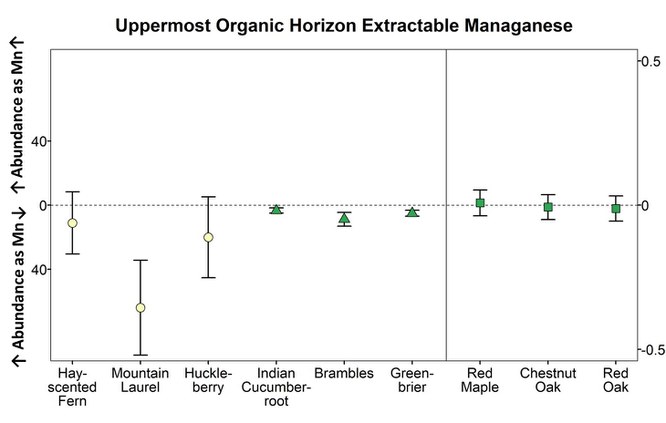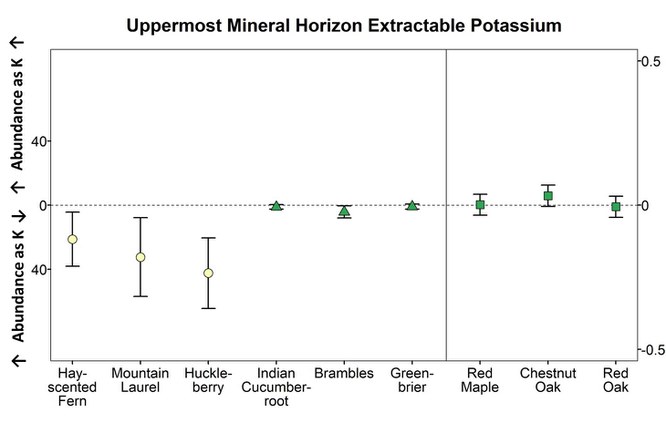After slowly starving over the winter months to survive, it is finally time to pack on the pounds and store enough energy to grow those little milk vampires.
Pennsylvania’s forests are extremely productive and can support a lot of deer. A single deer consumes an average of 1 kg (2.2 pounds) of forage per day during the summer months, and if you think about how much a leaf weighs – that is A LOT of vegetation. This is why when deer numbers are out of balance with their habitat, they can reduce tree regeneration and understory plant diversity.
However, we also know that deer aren’t the only factor affecting forest plants, and soils are really important in influencing forage quality. Soils can affect forage by changing the nutritional content of the leaves of a plant, or by affecting what plants grow in an area. Generally, soils influence both.
Of all the green stuff in the forest, only a small subset is classified as deer food. In a 2012 study, Sarah Pabian and her colleagues assessed the effectiveness of liming to improve deer forage quality, but only 13% of the vegetation she sampled was actually classified as deer food! Below is the breakdown of the nutritional content of the forage classes she sampled.
Notice how the nutrient content of forbs (non-grass-like herbaceous plants), across the board, topped vines (greenbriers) and the two most common tree seedlings in the forest. There wasn’t even a consistent second-place food source.
| Vegetation | Calcium | Magnesium | Potassium | Phosphorus | Crude Protein |
|---|---|---|---|---|---|
|
Forbs |
0.74 | 0.30 | 2.07 | 0.15 | 11.35 |
| Greenbriars | 0.58 | 0.13 | 1.26 | 0.11 | 9.93 |
| Oaks | 0.58 | 0.17 | 0.72 | 0.11 | 10.36 |
| Red maple | 0.63 | 0.13 | 0.58 | 0.12 | 7.71 |
In addition, Pabian et al. found that liming significantly improved the nutritional content of several of these plant groups, and that forbs (the most nutritious of all the deer food!) also increased in biomass after they were limed.
I wanted to know how soils affected forage in our southern study areas (Rothrock and Bald Eagle state forests), so I classified vegetation into non-preferred and preferred deer browsing categories and plotted how their abundance changed in response to soil chemistry. I considered mountain laurel, huckleberry, and hay-scented fern non-preferred deer browse, and all forbs and seedlings preferred browse.
In this post we’re going to look at the effect of soil pH, manganese, and potassium.
Species whose point estimates (circle, triangle, or square) and 95% credible intervals (vertical lines) are above the dashed line have greater abundance when the soil chemistry variable in the title is high. And vice versa.
In the graph below, non-preferred, lower quality forage (mountain laurel and huckleberry) was more abundant when pH was low. Higher quality forage was sometimes more abundant when pH was high, but most species’ abundances were unaffected by soil pH.

For manganese (below), high-quality forbs were more abundant when soil manganese was low, but there was no effect of manganese on seedlings or two of the three non-browse preferred species. This suggests that forbs are particularly sensitive to metals, and may explain why Pabian saw an increase in forb biomass when she limed and reduced metal availability in the soil.

For soil potassium (below), all three non-preferred, poor-quality forage species were more abundant when potassium was low. None of the high quality forbs or seedlings were affected by soil potassium.

Overall, there was generally more low quality vegetation associated with lower soil pH, higher soil manganese, and lower soil potassium. This suggests that not only does soil chemistry affect the nutritional content of plants, but also affects their relative abundances. A small shift in the amount of forbs due to high levels of soil manganese could have a big effect on forage quality, and sites with low organic horizon pH (2.4-3.5) and low potassium (< 0.4 cmol(+) per kg) are likely to be dominated by non-preferred forage in our study areas.
Soils are just another piece in the forest ecosystem puzzle, and how important they are is something we are still working to understand. White-tailed deer are still making milk vampires, growing antlers, and surviving the winter, because they are incredibly adaptable to a wide variety of habitats and habitat conditions.
What we don’t know is how forage has or will change through time, and how other species of wildlife are affected by shifts in available food sources. Plants affect not just the deer that eat them, but also other herbivores like insects and small mammals.
Quality forage is important for maintaining ecosystem productivity. Monitoring and managing the soil will help ensure that productivity continues well into the future.
-Danielle Begley-Miller, Ph.D.
Post-doctoral Scholar
Penn State University
If you would like to receive email alerts of new blog posts, subscribe here.
And Follow us on Twitter @WTDresearch
